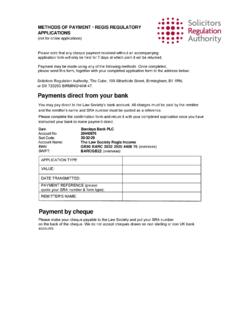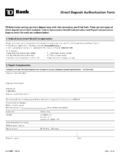Transcription of ACH Quick Reference Guide - We Want to Be Your Bank
1 2015 ACH Quick Reference Guide | IACH Quick Reference Guide2015 EDITIONThis user-friendly Guide is based on the 2015 NACHA Operating Rules (referred to as the ACH Rules), Regulation E and the Uniform Commercial Code Article 4A (UCC 4A) and supplements more extensive resource materials. It references various in-depth resource materials and is not intended as a substitute for referencing and complying with the rule requirements published in the ACH Rules. Procedures for handling federal government entries are not covered in this Guide . Although many procedures may be similar, federal government entries are also subject to Title 31 Code of Federal Regulations Part 210 (31 CFR Part 210), which are outlined in the Green Book. For a copy of the Green Book, visit of use are within the control of individual users. There is no warranty, expressed or implied, in connection with making this publication available, and EPCOR is in no way responsible for any errors or omissions in this Guide .
2 NACHA owns the copyright for the NACHA Operating Rules and To Use This Guide The purpose of the ACH Quick Reference Guide is to provide instruction to financial institution personnel involved in the day-to-day activities associated with receiving commercial ACH transactions. It is ideal for training personnel on ACH procedures and as a Quick Reference for ACH questions. The Guide contains an appendix with sample reports, Return and Notification of Change codes, and a glossary of ACH , as a direct Member of NACHA, is a specially recognized and licensed provider of ACH education, publications and | 2015 ACH Quick Reference GuideTable of ContentsACH Basics ..1 What is the ACH Network? ..1 Who are the ACH Participants? ..1 How does the ACH Network Function? ..2 How are ACH Funds Settled? ..3 ACH Network Management ..4 ACH Rules and Regulations ..4 ACH Rules ..4 Office of Foreign Assets Control (OFAC).
3 4 Regulation E and Electronic Fund Transfer Act (EFTA) ..5 State Law ..5 Title 31 Code of Federal Regulation Part 210 (31 CFR Part 210) ..5 Uniform Commercial Code Article 4A (UCC 4A) ..5 USA PATRIOT Act ..5 ACH Transactions ..6 Types of ACH Transactions ..6 Transaction Codes ..7 Standard Entry Class (SEC) Codes ..8 Authorization ..10 Rules Compliance ..11 Reporting and Disclosure Requirements ..11 The ACH Rules Disclosure Requirement ..11 Periodic Statement ..11 UCC 4A Disclosure Availability ..11 Notice Requirement ..11 Choice of Law .. 12 Regulation E Disclosure Requirements ..12 Initial Disclosure ..12 Periodic Disclosure (Account Statement) ..12 Risk Management and Assessment ..13 ACH Credit Risk ..13 Controlling Credit Risk ..13 ACH Operational Risk ..13 Controlling ACH Operational Risk ..13 ACH Fraud Risk ..13 Controlling ACH Fraud Practices ..13 ACH Audit ..14 Data Security Requirements.
4 14 What If the RDFI is Not in Compliance? ..14 Daily Operations ..16 Receiving ACH Activity ..16 Current Federal Reserve ACH Deposit Schedule ..162015 ACH Quick Reference Guide | IIIT able of ContentsAccepting ACH Transactions ..16 Posting ACH Transactions ..17 Timing ..17 Account Identification ..17 Funds Availability Compliance ..17 Daily Reports ..18 The Daily Activity Report ..18 Daily Reconcilement ..18 Control Reports ..18 Entries with Addenda Records ..19 Prenotifications ..20 Commercial Reclamation Entries ..20 Federal Government Reclamation Entries ..21 Acknowledgment Entries (ACK & ATX) ..21 Destroyed Check Entries (XCK) ..22 International ACH Transactions (IAT) ..22 ACH Exception ..24 Written Statement of Unauthorized Reasons by ACH Application ..25Re-presented Check (RCK) Entries ..26 International ACH Transactions (IAT) ..27 Corporate Debit Entries to a Consumer Account.
5 27 Corporate Entries ..27 Prenotification Entries ..27 ACH Operator Rejects ..28 Dishonored Returns ..28 Contested Dishonored Returns ..28 Notifications of Change (NOC) ..29 Other Exceptions ..31 Duplicate Files ..31 Reversals ..31 Reversals Due to Separation of Employment ..31 ODFI Request for Return ..32 Remakes ..32 Processing Delays .. Resources .. ACH Quick Reference Guide | 1 ACH BasicsWhat is the ACH Network? Who are the ACH Participants? The Automated Clearing House (ACH) Network is an electronic payments network used by individuals, businesses, financial institutions and government organizations. It allows funds to be electronically debited or credited to a checking account, savings account, financial institution general ledger account or credited to a loan ACH Network is the backbone for the electronic movement of money and other related data, providing a safe, secure, reliable network for direct consumer, business and government payments .
6 Large and small financial institutions of all kinds jointly govern and utilize the ACH Network, facilitating billions of payments such as direct Deposit via ACH and direct Payment via ACH. The ACH Network is a batch processing, store-and-forward system. Transactions are stored by financial institutions throughout the day and processed at specified times in a batch ACH Network exchanges funds and payment-related information throughout the United States, its territories and are five key participants that contribute to the successful completion of an ACH transaction. As each participant is discussed, the financial institution should better understand the role it plays in the Originator is the company/business that has been authorized by the Receiver to either credit or debit an account. When a company initiates a credit transaction to their employee s account for payroll or to a business customer s account for payment of goods and services, it is considered the Originator.
7 Originators may also initiate debit transactions to a consumer or business account for payment of goods or services. The Receiver can be either an individual or a company that has authorized the Originator (company) to credit or debit their account. The employee is the Receiver if his/her employer is initiating a direct Deposit payroll credit. A business partner is the Receiver if the Originator is sending a credit to pay for goods or services. The Originator can also be a Receiver, in situations where another party is initiating credits or debits to their account. The authorization is a key component of an ACH transaction, as it gives the Originator the authority to send credit or debit transactions to the Receiver s account. The manner in which the authorization may be obtained varies based on the type of transaction and is discussed in greater detail in the Authorization section of this Guide .
8 The Originating Depository Financial Institution (ODFI) is the financial institution with which the Originator (company) has a contractual relationship for ACH services and is responsible for sending ACH entries into the ACH Network on behalf of the Originator. Through the warranties outlined in the ACH Rules, the ODFI has the greatest liability of all the participants in the ACH Network. The contractual relationship between the Originator and the ODFI outlines the rights and responsibilities of the two parties with respect to the ACH transactions being originated and provides the ODFI with a mechanism to pass some appropriate liabilities to the Originator (company). An example of this relates to authorizations. The ODFI warrants to all the other Network participants that transactions are properly authorized; and yet, the Originator obtains and maintains this authorization.
9 Hence, the agreement between the Originator and ODFI will undoubtedly address the Originator s responsibilities regarding authorizations. The ACH Operator is the central clearing facility for ACH transactions. The ACH Operator is responsible for accepting files of ACH entries from ODFIs, which are then sorted, batched and forwarded to the Receiver s financial institution. The ACH Operator also performs some editing functions, ensuring that mandatory information required in ACH records is included. There are currently two ACH Operators, the Federal Reserve bank and EPN (Electronic payments Network).The Receiving Depository Financial Institution (RDFI) is a financial institution with which the Receiver has an account relationship. Credit or debit entries sent to a Receiver s account will be received by the RDFI from the ACH Operator and then posted to the Receiver s account.
10 The RDFI s primary responsibilities are to: 1. Post ACH entries to the Receiver s account. 2. Make funds available to the Receiver for credit entries or debit the Receiver s account on the Settlement Date. 3. Provide information regarding each ACH transaction to the Receiver on their statement. 4. Return ACH entries, within the specified timeframes, when the transactions cannot be posted. 2 | 2015 ACH Quick Reference GuideACH BasicsThere are two other Network participants that may be involved in the flow of transactions, Third-Party Service Providers and Third-Party Senders. A Third-Party Service Provider is a party which performs an ACH processing function on behalf of the Originator, ODFI or RDFI. A payroll processor is a common example of a Third-Party Service Provider used by Originators. A subset of Third-Party Service Providers sending or receiving ACH files on behalf of a financial institution are known as Third-Party Sending Points and Third-Party Receiving Points, respectively.




